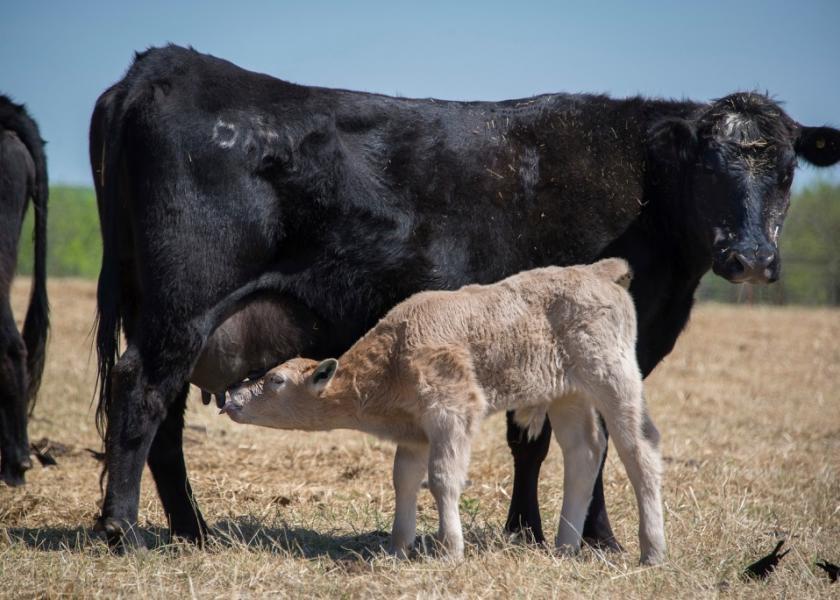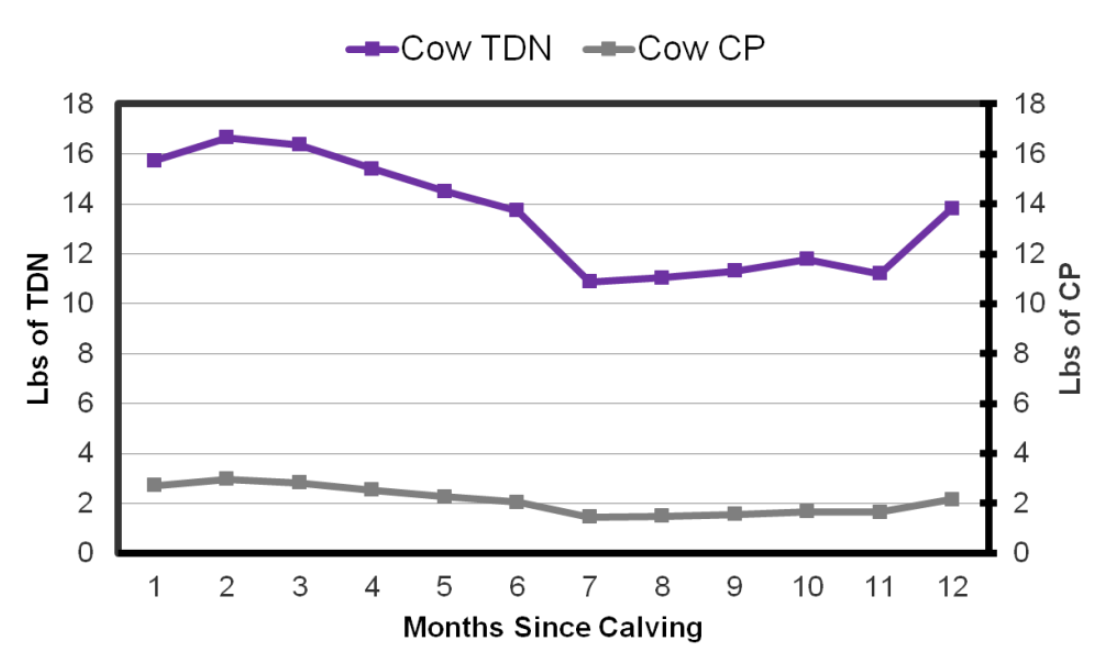Managing Fall Calving Cows is Different than Spring Calving Cows, Especially During Drought

September is calving season for many fall-calving herds. Nutritional management of fall-calving cows is a little different than spring-calving herds throughout the production cycle. Peak energy, measured as total digestible nutrients (TDN), and protein requirements occur early in lactation at about 1 to 3 months after calving (Figure 1, below).
For spring-calving cows, the calving season is typically aligned with peak energy and protein requirements occurring at the time pastures green up such that the young tender grass with high protein and digestibility can meet those nutrient requirements.
For fall-calving cows, the ability of pasture to meet peak energy and protein requirements is highly dependent upon the forage species. Cool-season forages such as fescue regrow in the fall when temperatures begin to cool down providing highly nutritious grass to meet the requirements of the cow during this time.
However, warm-season forages are slowing growth as temperatures decline and becoming dormant having much lower nutritive value and less ability to meet the nutrient requirement of cows in early lactation.
But, stockpiled bermudagrass or native grass with protein supplementation can effectively meet the nutrient requirements of fall-calving cows.
And planting cool-season annual forages can easily meet the nutrient requirements of lactating beef cows, and can even be used as a supplement to warm-season pasture by limiting the time cows graze the annuals each day.
Fall-calving cows have a couple of advantages. One advantage is the climate which is typically dry and cool, which does not increase maintenance requirements like cold and wet conditions in the spring.
The second advantage is that fall-calving cows came through the summer grazing months without a nursing calf and are usually in very good body condition; 6 or better. Greater body condition at calving allows these cows to lose some condition without detrimental effects on reproductive performance.
The breeding season for fall-calving cows is usually late November through December such that cows are pregnant before bad winter weather. Pregnant cows are unlikely to lose a pregnancy due to poor body condition, which allows fall-calving cows to lose some condition through the winter. This works financially because cows will be able to regain lost condition inexpensively on pasture next summer.
It is not advisable to let spring-calving cows lose condition through the winter leading up to calving as it is not economically feasible to regain condition between calving and breeding seasons.
A possible disadvantage of fall-calving cows is that some feeds available in the fall of the year may not be suitable. As displayed in Figure 1, the energy requirement is much greater than the protein requirement and is expensive to provide because of the tonnage necessary. Thus, feedstuffs with lower digestibility may not be good options. For example, corn stalks can readily meet the nutrient requirements of spring calving cows after weaning, but may not work for fall-calving cows except for a few weeks early on when cows are consuming leaves, husks, and down ears.
Other feeds such as ammoniated wheat-straw will require significant energy supplementation to meet energy requirements of cows in lactation and high levels of ammonia intake may have negative effects on reproductive performance.
Fall-calving cows can be especially challenging in a drought. Forage production was less than usually so cows are thinner than usual at calving and do not have the surplus fat to lose condition through early lactation and breeding.
Additionally, alternative forages such as crop residue or wheat straw will require substantial supplemental grains and byproducts to meet nutrient requirements.
Meeting nutrient requirements during the time between calving and breeding is critical if cows are only in moderate body condition because the loss in pregnancy rate will impact the ranch for several years to come.
Planting cool-season annuals is an option, but requires fall rains to get the crop established, and if not established early in the fall, forage growth will be too little for winter grazing.
Plan on feeding a considerable amount of supplement to fall-calving cows during fall and winter in drought years. Conventional feedstuffs are likely to be expensive as demand is high and supply may be low.
Look for alternative feeds such as failed crops, spent grains from local breweries, fruit and vegetable waste from local supermarkets, etc. Any untapped waste stream that provides rumen-digestible, safe feedstuff that is less expensive per unit of energy (TDN) will be advantageous during drought.








